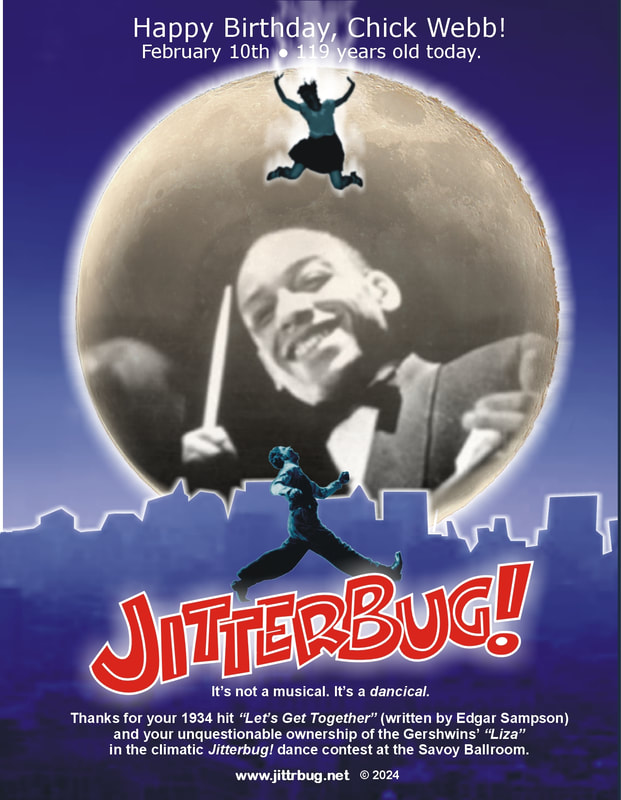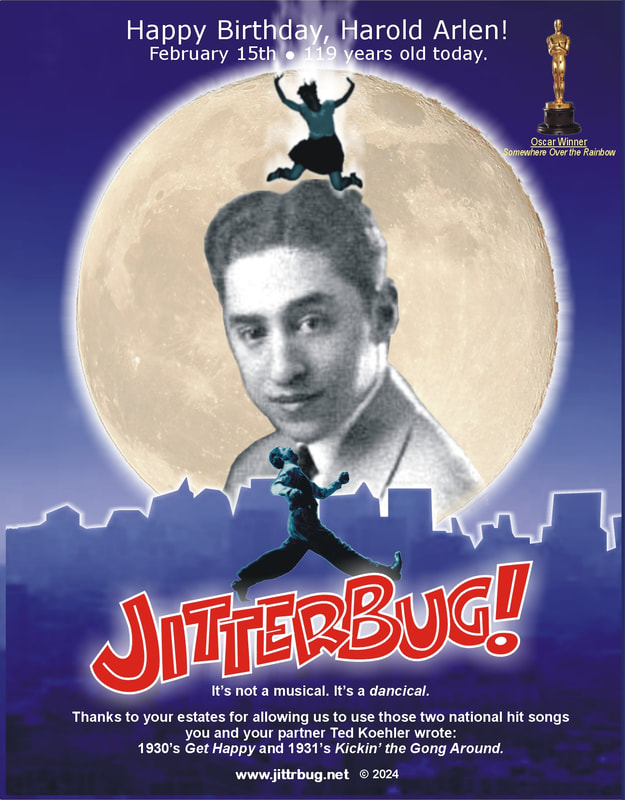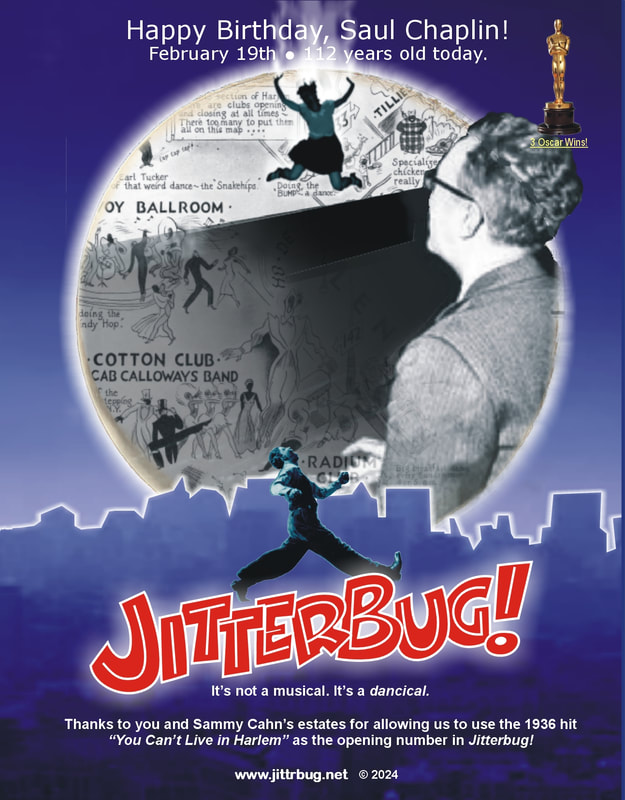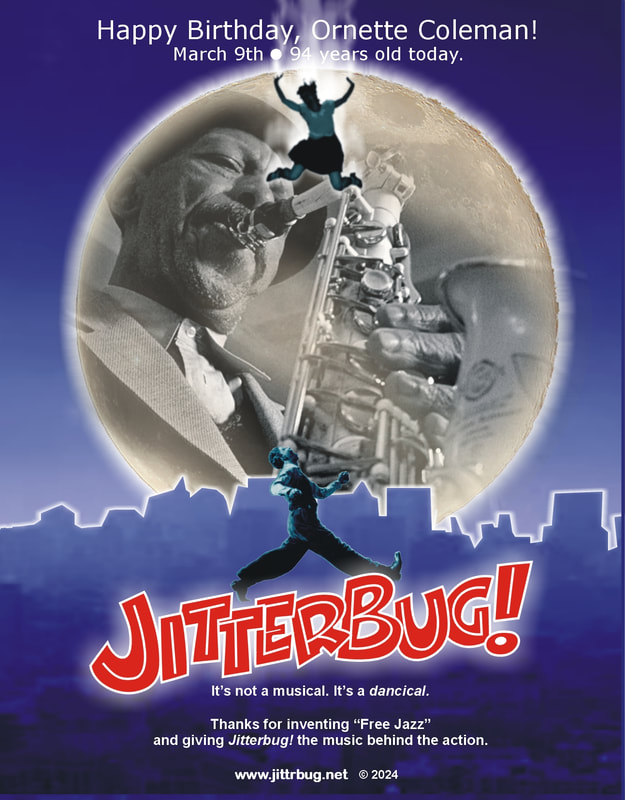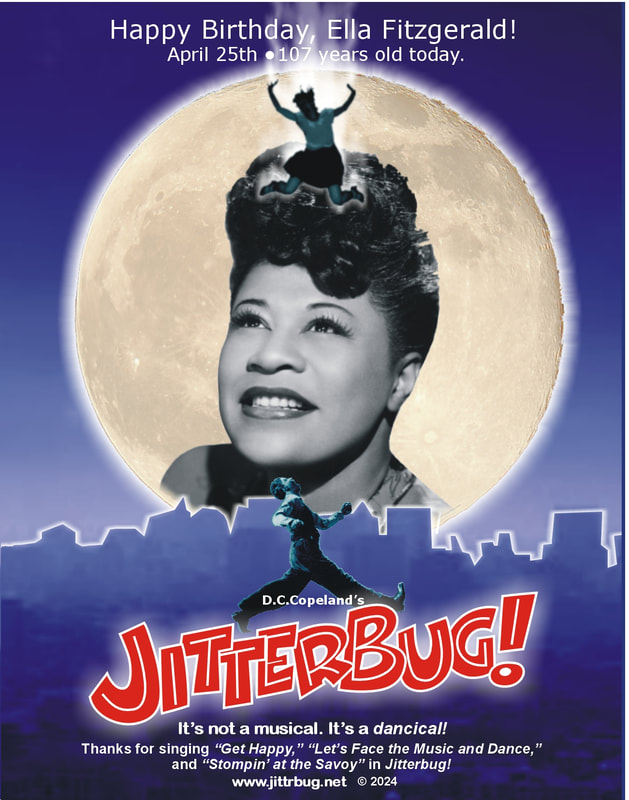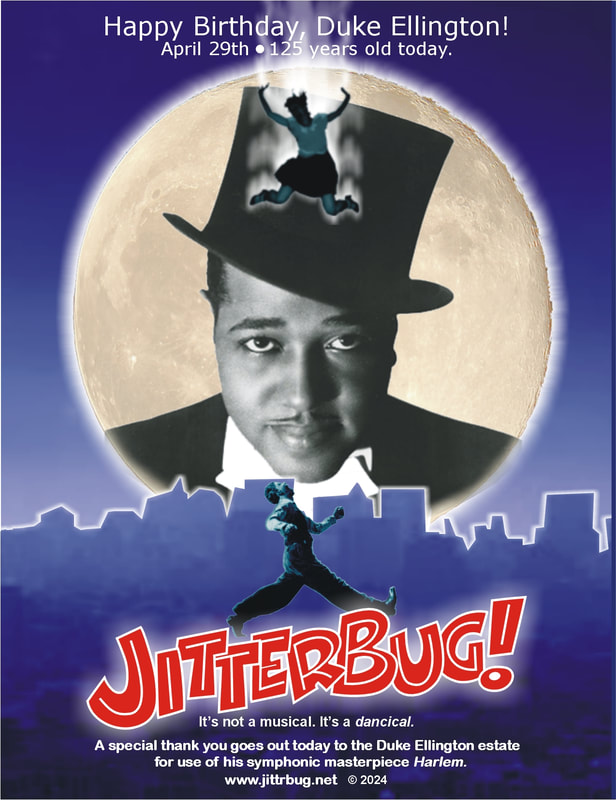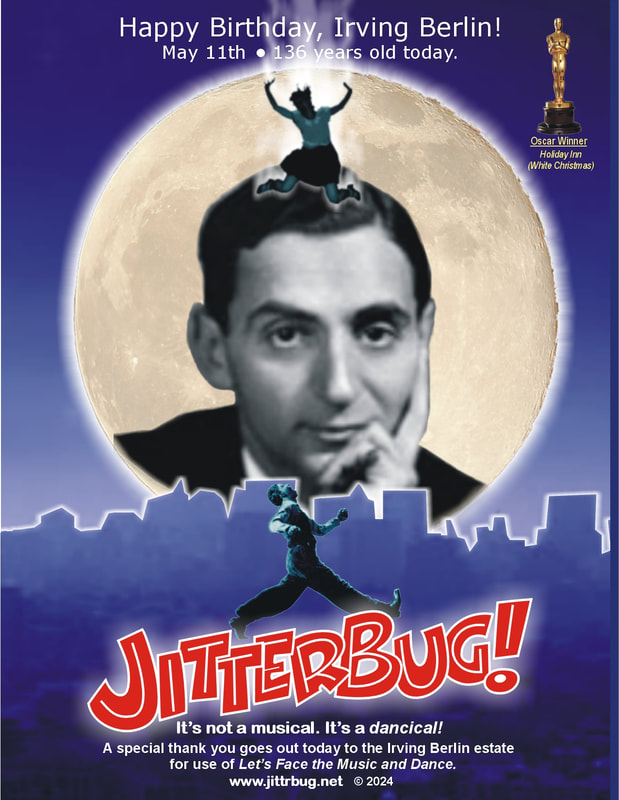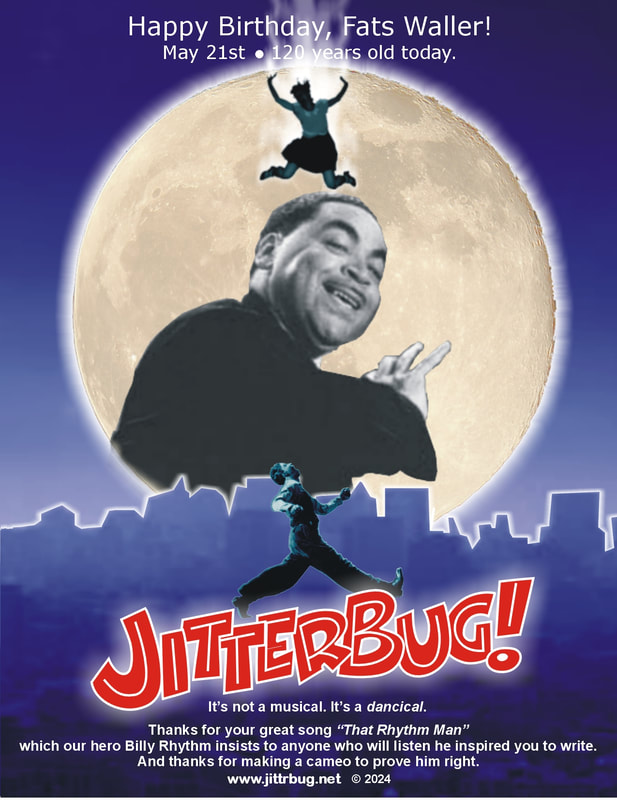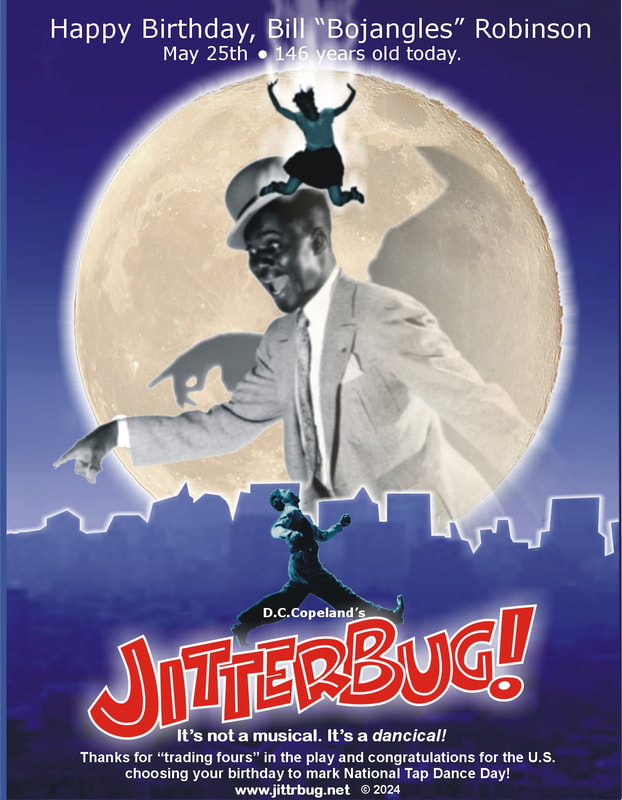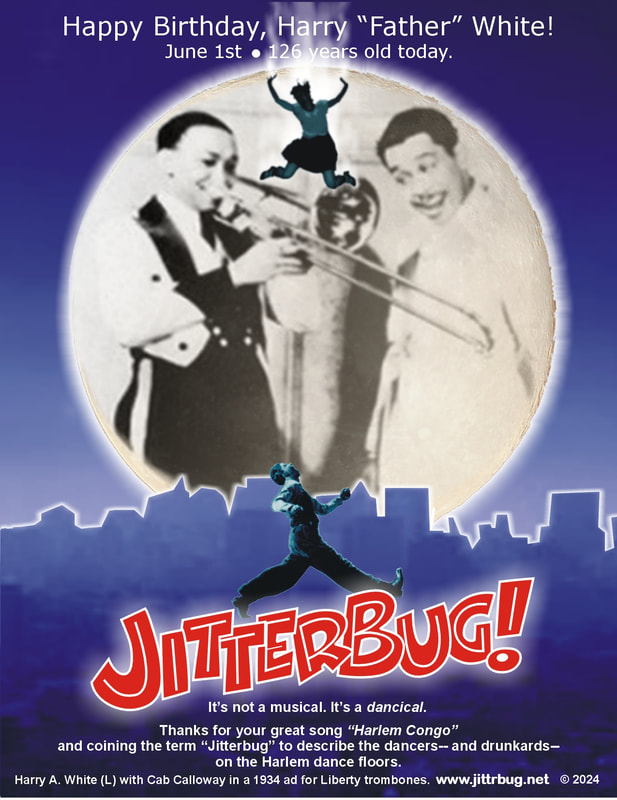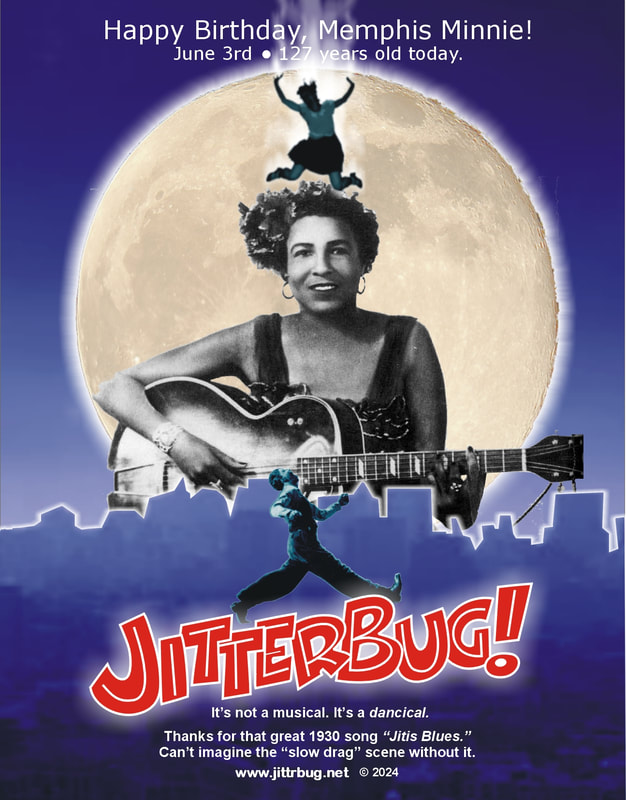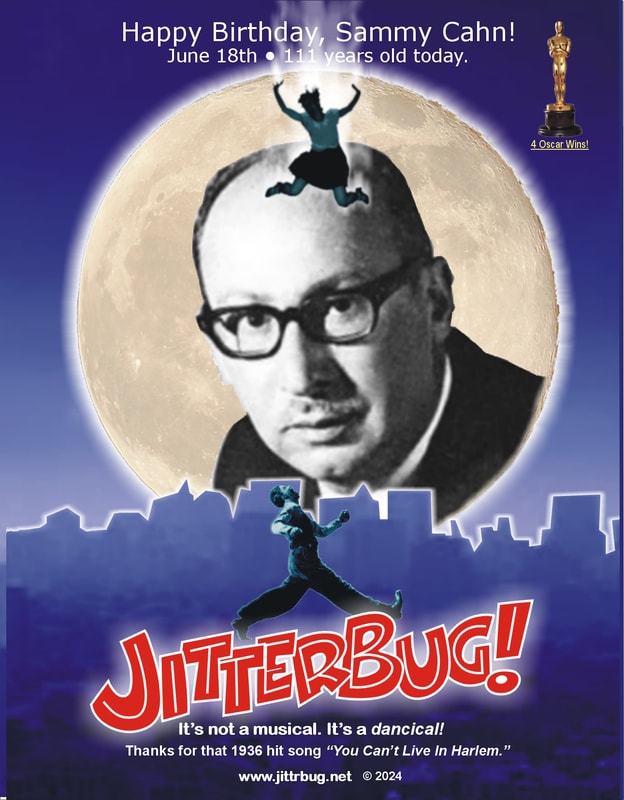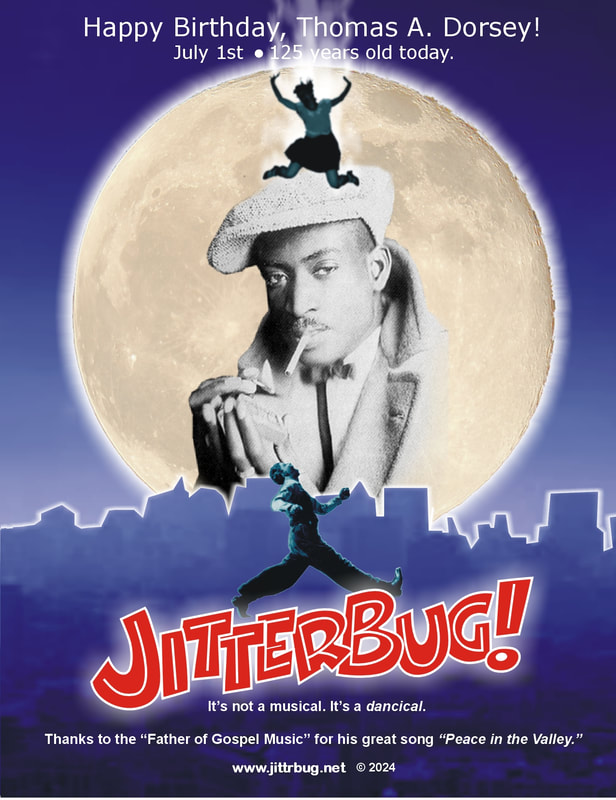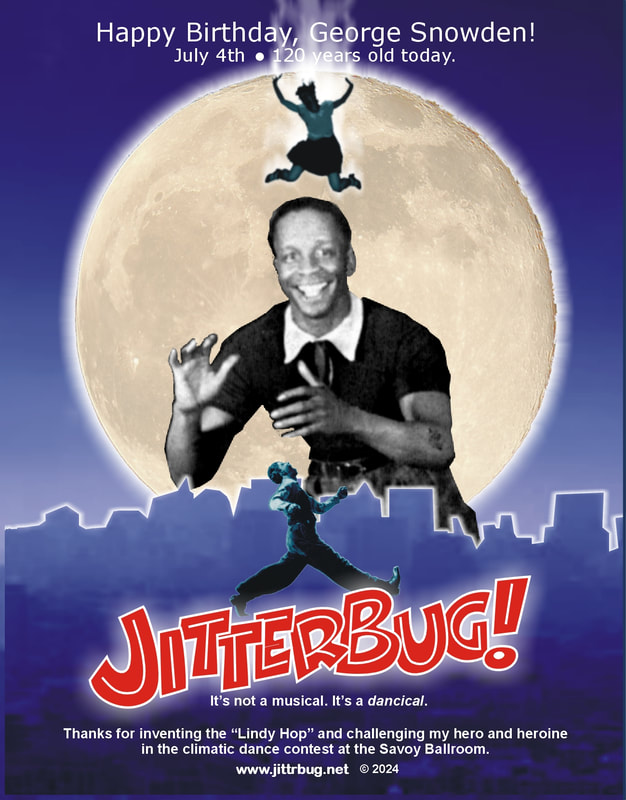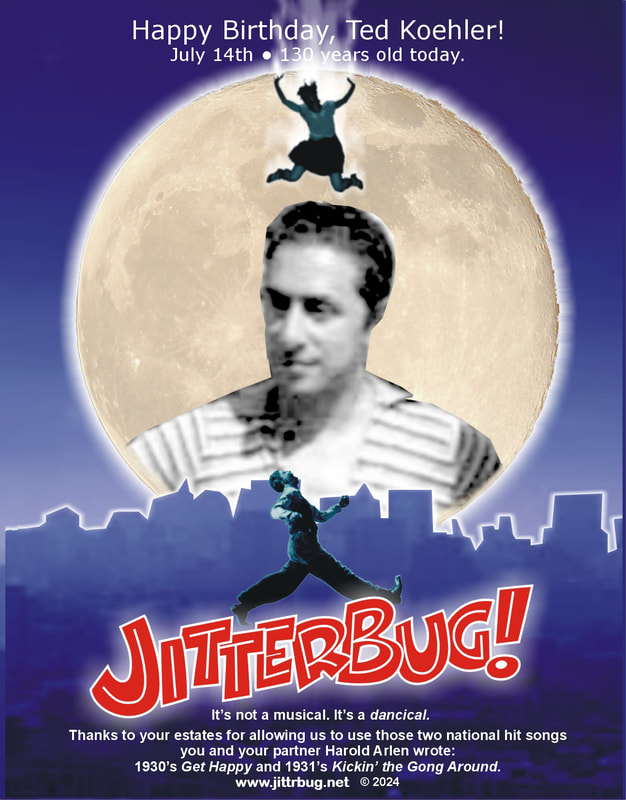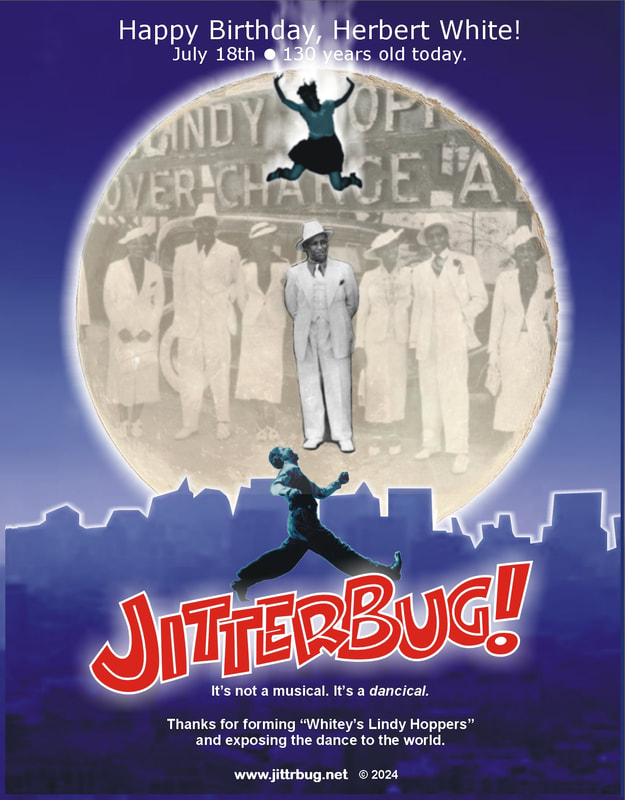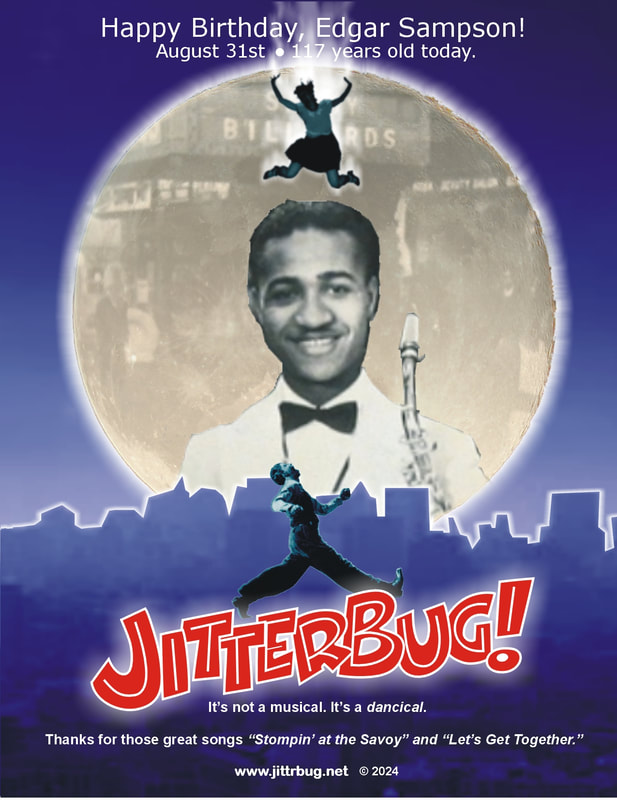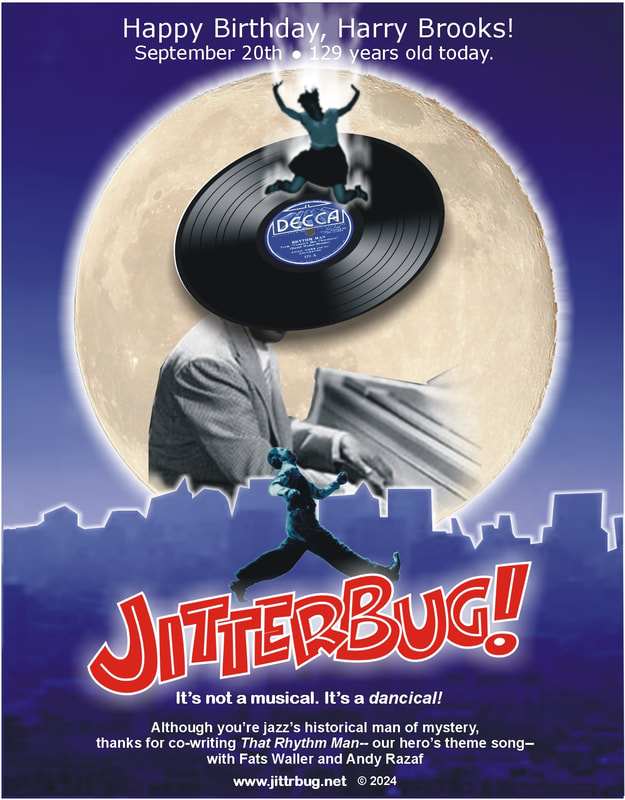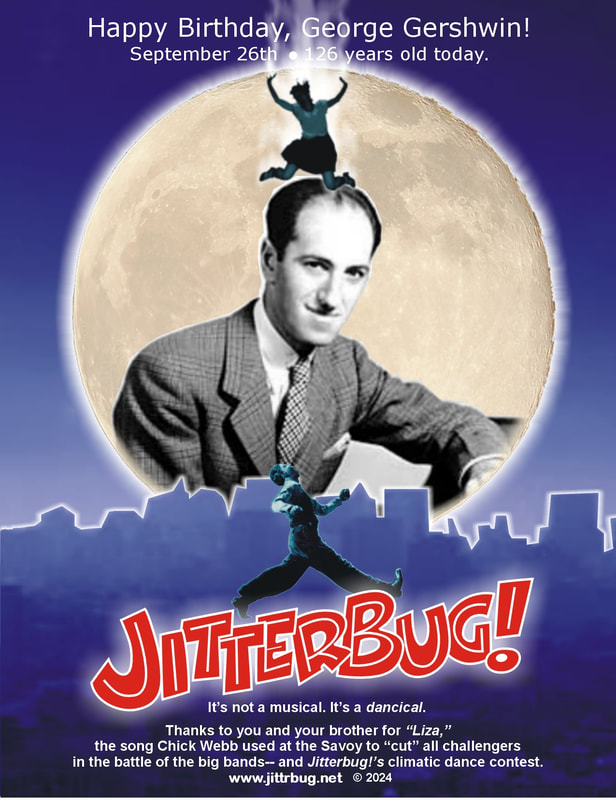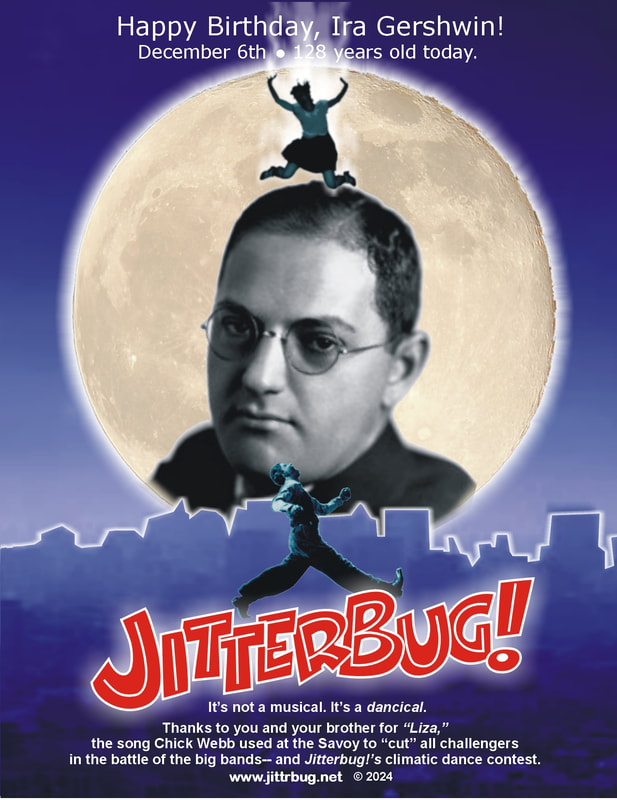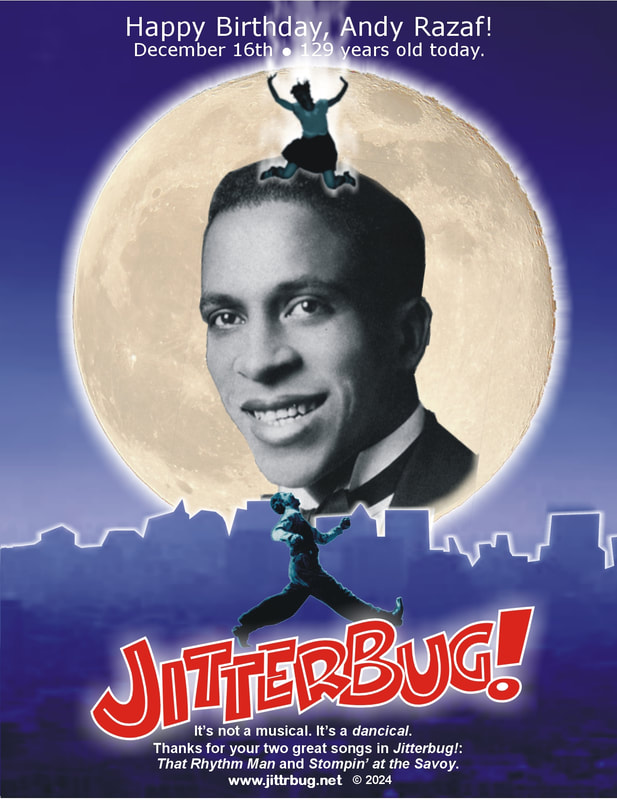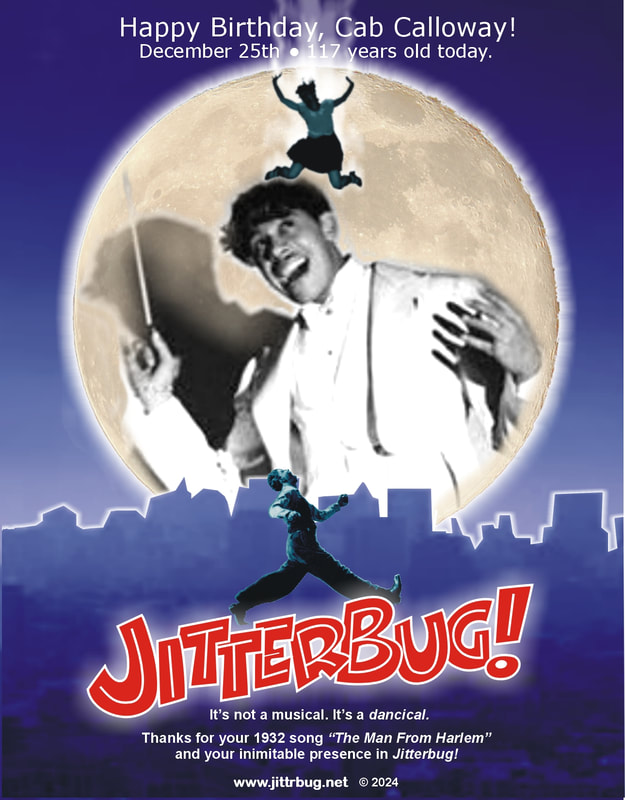Jittrbug.net
- Home
- News
- Blog
- Video Trailer
- Screenplay
- Jitterbug! Songwriting Team & Creative Directors
- Music
- The Story
- The Dramaturgy Behind The Story
- Jitterbug Dance Origins
- Get Your Choreography Right Here!
- Map of historic locations in play
- Playwright
- The Director
- The Choreographer
- Jitterbug! NYC Pixs
- Emerging Artists Theatre (EAT)
- Tada! Youth Theatre
- National Black Theatre
- The National Black Theatre Cast
- Follow-up to the NBT radio reading
- Books
- Educator Resources
- Royalties
- Everything Jitterbug! Store
- Gallery
- Contact
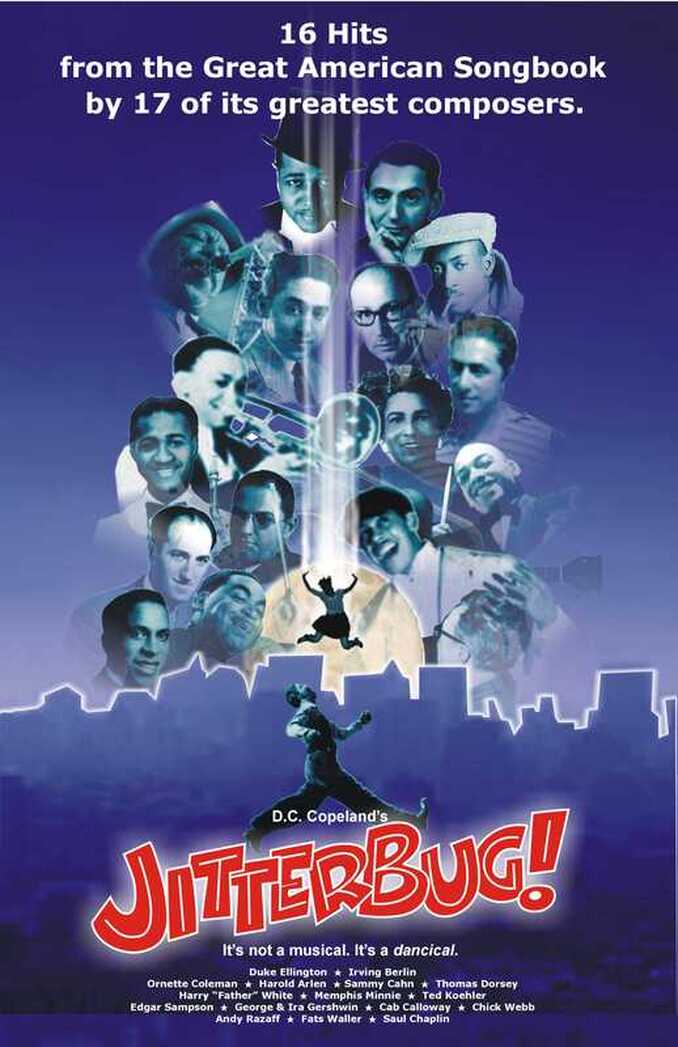
This page celebrates the uniquely American Geniuses of the Jitterbug! Songwriting Team, Creative Directors, and Dance Makers. They are listed by their birthdays. Scrolling through them, you will find information regarding their careers and how they contributed to Jitterbug! Many of the song titles are linked to YouTube with just a click. Stage production rights secured.
February 10: Chick Webb February 15: Harold Arlen February 19: Saul Chaplin March 19: Ornette Coleman
April 25: Ella Fitzgerald April 29: Duke Ellington May 11: Irving Berlin May 21: Fats Waller
May 25: Bojangles June 1: Harry White June 3: Memphis Minnie June 18: Sammy Cahn
July 1: Thomas A Dorsey July 4: George Snowden July 14: Ted Koehler July 18: Herbert White
August 31: Edgar Sampson September 20: Harry Brooks September 26: George Gershwin
December 6: Ira Gershwin December 16: Andy Razaf December 25: Cab Calloway
April 25: Ella Fitzgerald April 29: Duke Ellington May 11: Irving Berlin May 21: Fats Waller
May 25: Bojangles June 1: Harry White June 3: Memphis Minnie June 18: Sammy Cahn
July 1: Thomas A Dorsey July 4: George Snowden July 14: Ted Koehler July 18: Herbert White
August 31: Edgar Sampson September 20: Harry Brooks September 26: George Gershwin
December 6: Ira Gershwin December 16: Andy Razaf December 25: Cab Calloway
February 10
"Chicklet" and the "King of Swing" as Chick Webb was known to his many fans, was the main house band at the Savoy Ballroom up until his early death in 1939 from complications of contracting tuberculous of the spine when he was a child. The disease stunted his growth so that he grew no taller than four-feet. In 1934 he hired 18-year old Ella Fitzgerald to sing in his band. When he died, she became the leader of the band, renaming it "Ella Fitzgerald and her Famous Orchestra."
Here's the only film known to exist of Chick Webb playing his drums and leading his band:
February 15
In 1930, Harold Arlen, then 25, and his writing partner at the time of the play, Ted Koehler, 36, started writing for the mob, i.e. creating two revues a year for the Cotton Club which was owned by mobster Owney "The Killer" Madden. Arlen and Koehler took the job coming off their national hit record Get Happy. Together the guys wrote the following hits for the Cotton Club revues: Between the Devil and the Deep Blue Sea (1931), I Love A Parade (1931), I've Got The World On A String (1932), and Stormy Weather, a 1933 hit introduced to the world by the late, great Ethel Waters who described Arlen as the "Negroest white man I ever knew." Not bad for the son of a Jewish cantor. Arlen would later go on to write the "Song of the Century" for the "The Wizard of Oz," Somewhere Over The Rainbow. Arlen died in 1986 at the age of 81.
February 19
Saul Chaplin won three Oscars and was nominated for two during his illustrious career following his early years in NYC. The Oscars were for "Scoring a Musical Picture": An American in Paris (1955), Seven Brides for Seven Brothers (1957), and West Side Story (1962). Jitterbug! opens with Cahn and Chaplin's 1936 hit You Can't Live In Harlem, playing on a radio perched on an open window of a Harlem tenement as the show's hero Billy Rhythm walks across the stage, suitcase in hand, soaking up the energy from the people walking up and down the street. Music by Noble Sissle and his Orchestra and sung by Sidney Bechet. This is the first of many examples throughout the dancical of the uniquely American collaboration between white and black songwriters and musicians.
March 9
Although Ornette Coleman was born in 1930, a year before Jitterbug! takes place, his music is used cinematically for certain scenes in the dancical. In the 1950's he created a style of improvising with other jazz musicians called "Free Jazz," a term he invented to describe this new sound which, unlike bebop, was freer and less rigid. Playing what he "heard" and "playing in the cracks" of the scale made many jazz musicians think he was playing out of tune. This free approach to the music made it difficult for many of them to play with him, a trait that began when he was just starting out as a professional musician: while playing in a blues band in Baton Rouge, it was the dancers in a hot and muggy juke joint who rebelled against his playing style because they couldn't dance to it by beating him up and tossing his sax over a cliff. Today, his music inspires the interpretive moves of Modern Dance and other forms of contemporary dance. His The Artists in America piece from 1972's Skies of America album is used to accent Billy Rhythm's stylistic beating on a Harlem street, starting at :20 on the YouTube selection below. We love the metaphor with the title and the tune's discordant music because it reminds us Billy is an American dance artist whose new way of moving is shaking up the status quo and causing equal discord as all new art forms usually do. BTW, this is the first time the character "Ornette" makes his appearance. Wearing an old fedora, he always steps out of the shadows unannounced, playing his sax to accent the darker side of the dancical and to foreshadow deadlier things to come.
April 25
Jitterbug! makes subtle artistic liberties to work songs and dance styles into the dancical's 1931 time frame. Ella Fitzgerald at that time was only 14-years old. However, when she was 18, Chick Webb hired her to sing in his band and would later record songs that were chosen for Jitterbug!, songs that were only a few years before or after that date: "Get Happy" (1930), "Stompin' at the Savoy" (1934), and "Let's Face the Music and Dance" (1936). She had her first #1 hit in the "pre-chart era" in 1938 when she was 21: "A-Tisket, A-Tasket." She co-wrote this song with Van Alexander, a 23-year-old Jewish kid who was selling arrangements to Chick Webb who recorded it as single. She began her career by winning the 1934 Amateur Night at the Apollo Theatre competition when she was 17. By the time of her death in 1996 at the age of 79, she had won 14 Grammys and the Presidential Medal of Freedom, America's highest non-military honor.
April 29
Jitterbug! begins when Duke Ellington and his orchestra quit the Cotton Club in 1931 to film their first Hollywood movie, Black and Tan. He was replaced by the then unknown 22-year-old Cab Calloway and his 11-piece band The Missourians. Although the 32-year-old Ellington would return periodically through the 30's to play at the club, he and his band were on a world famous trajectory that nothing could hold back thanks, in part, to the world's first live national weekly radio broadcasts from the Cotton Club that began with his hiring in 1927. Before vacating the Cotton Club he had written his signature piece "Mood Indigo" (1930). By the time of his death in 1979 at the age of 75, he had won 14 Grammys. the Presidential Medal of Freedom, and the Pulitzer Prize.
The short clip below explains how Duke Ellington got the gig at the Cotton Club with archival video and interviews with Ellington and his manager, the legendary Irving Mills, founder of Mills Publishing and a recording arm which became Columbia Records. The clip segues into "Part 2" and is worth the watch because it shows Ellington playing at the Club during a show.
The short clip below explains how Duke Ellington got the gig at the Cotton Club with archival video and interviews with Ellington and his manager, the legendary Irving Mills, founder of Mills Publishing and a recording arm which became Columbia Records. The clip segues into "Part 2" and is worth the watch because it shows Ellington playing at the Club during a show.
May 11
Considered one of the greatest songwriters in American history (White Christmas, God Bless America, Puttin' on the Ritz, There's No Business Like Show Business, etc), Irving Berlin's great 1936 hit "Let's Face the Music and Dance" is used to close Jitterbng!'s first act. The lyrics are perfect for the dance scene, as if they were written for it. Although it first appeared in the Fred Astaire and Ginger Rogers movie Follow the Fleet, with Fred singing, Ella Fitzgerald's 1958 version was chosen for the dancical because of its darker tone. Berlin is the 3rd and last songwriter on the team to win the Presidential Medal of Freedom. However he joins George and Ira Gershwin as three of the five songwriters ever to win the Congressional Gold Medal. The only other songwriters to win this second highest civilian award were George M. Cohan and Harry Chapin.
May 21
Thomas Wright Waller was born in Harlem. Overcoming the objections of his preacher father, Waller started playing piano professionally at age 15. His "Harlem stride piano playing style" influenced modern jazz piano. Between him and his songwriting partner Andy Razaf, they copyrighted over 400 songs including "Ain't Misbehavin," and "Honeysuckle Rose." He appeared in several feature films including "Stormy Weather" (1943). He died a few months later from pneumonia. His Harlem funeral attracted over 4,000 people prompting Adam Clayton Powell, Jr during his eulogy to say, "Fats Waller always played to a packed house." Winner of 3 Grammys, including a Lifetime Achievement Award.
May 25
Arguably the most famous tap dancer that ever lived, Bill "Bojangles" Robinson is the oldest Jitterbug! contributor having been born in 1878. However, in 1931, when he's 53-years-old, few people outside of NYC had ever heard of him. That changes 4-years later when he makes his first film of four with Shirley Temple: The Little Colonel. Their paring marks the first time Hollywood showed an interracial dance couple, something so controversial that theaters in the south would not show the movie unless those scenes were deleted. Fondly called the "Mayor of Harlem" by Harlemites, he was penniless by the time he died in 1949 at the age of 71 having given away most of what money he had to people in need. His good friend Ed Sullivan paid for his funeral which was held at the 369th Infantry Regiment Armory in Harlem. Over 32,000 people attended his funeral with an estimated half-million more standing in silent tribute as his funeral cortege passed on its way to Brooklyn's Cemetery of the Evergreens, which has made a video about Bojangles' funeral here.
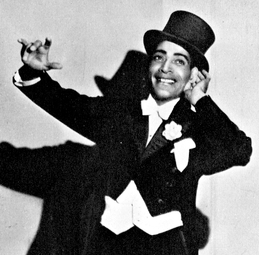 Eddie Rector
Eddie Rector
Below is a great scene from the 1943 film Stormy Weather that showcases Robinson, an elegant and eternally cool Calloway in tails, the amazing, mind-blowing dancing of the Nicholas Brothers, who, after this number, set the bar so high on a "show stopper" that no one-- much less dancing siblings-- will ever be able to top it, and a stage filled with more zoot suits on men and women dancers than you can shake a stick at. From a vernacular dance historian's perspective, it also shows in one amazing scene the evolution of tap dancing; from the minstrel era of Bojangles' hoofer style which emphasized footwork while more or less standing in place, to the exploding freedom exemplified by Fayard and Harold Nicholas. The brothers-- like many tap dancers back then such as Fred Astaire and Gene Kelly-- were inspired by the legendary black tap dancer Eddie Rector* who, around the early 1920's, loosened up the whole body and began using his hands and arms as well as his tap dancing feet to... travel gracefully across the stage. Tap dancers back then called it "stage dancing" and its what we come to expect to see on Broadway and film today.
*Like Cab Calloway, Rector, 17-years older than Cab, was also born on Christmas Day (1890).
*Like Cab Calloway, Rector, 17-years older than Cab, was also born on Christmas Day (1890).
Finally, here's a video of Bill Robinson just weeks before he died. It was shot on October 18, 1949 and he died on November 25th. It's from Ted Mack's Original Amateur Hour. A young tap dancer named "Wee" Willie Smith just finishes a tap dance routine when Ted Mack announces that Bill is in the audience. Smith is shocked as Bill gets to his feet to thunderous applause. Mack invites him up on the stage and this is the part that is so haunting to me. The Bill Robinson I knew from Stearns' Jazz Dance, the book that to a great degree inspired Jitterbug!, had... evolved. Back in the early 1930's he's depicted as a tough guy who was known to put his gold plated pistol on a pool table to silence the hub bub around him before making a critical shot. This was before he caught the eye of Hollywood. Now we see a 71-years old man who would be dead in five weeks, an old man who was brought to tears on that early TV show. Between the time he shot pool in that long gone Harlem speakeasy and the time he congratulated Smith, he had mellowed, had, in my mind, become gracious and thankful for a wonderful life, a life he probably sensed was nearing an end. We get a hint of this transformation in Jazz Dance when Stearns tells us the story of his funeral, how he died penniless because he gave his money away to people who needed it. But we see it here, in his last live appearance in the world he came into and helped change for the better.
June 1
Known as "Father" to the guys in the bands he played with because he was older than most of them (he's 33-years old at the time of this play), Harry A. White is most famous for his trombone playing and arranging. And giving the world the word "jitterbug." In 1934, while playing in the Cab Calloway Orchestra (Cab is 25 and in his last year at the Cotton Club), 24-year-old Edwin Swayzee, one of the orchestra's trumpet players, overhears White using the word "jitterbug" to describe people with alcoholic tremors. Thanks to Cab's recording of "The Jitterbug" (a song that has nothing to do with the dance) the word is quickly appropriated by people to describe the new hyper-paced dancing style sweeping the nation.
June 3
Born Lizzie Douglas in 1897, Memphis Minnie is the only woman songwriter on Jitterbug!'s creative team, an impressive accomplishment considering who she's sharing the limelight with and what she had to overcome to get there. Although the reasons why she ran away from her Mississippi family farm at the age of 13 are lost to history, we do know she made her way to Memphis, TN to live and play her guitar and sing on Beale Street, a nearly two-mile stretch of road running westward up from the Mississippi River. Home to black blues musicians since the 1860's, by the time she got there in 1910, the legendary street was lined with clubs and restaurants, many of them black owned. She spent most of her teens entertaining on those street corners, returning only to her family when she ran out of money. In 1916 she landed a gig with the Ringling Bros Circus and toured with it until 1920. By the time of her death in 1973 at the age of 76, she had released over 200 songs in a recording career that lasted from the 1920's through the 1950's. The song "Jitis Blues" (1930), recorded when she was 33-years-old, is about dying from meningitis. It's used as background music for the Harlem rent party's slow drag scene and is instrumental in setting the sensual tone and foreshadowing the violent and deadly ending of the first act.
On April 2, 2016, her work was recognized by the new National Blues Museum in St. Louis, MO at its Grand Opening with a permanent place in the pantheon of blues greats.
On April 2, 2016, her work was recognized by the new National Blues Museum in St. Louis, MO at its Grand Opening with a permanent place in the pantheon of blues greats.
June 18
Sammy Cahn started out as a Borscht Belt songwriter churning out lyrics from a small room with his first songwriting partner Saul Chaplin in the offices of Beckman and Prasky on West 45th Street in NYC. Cahn use to joke that after years of writing lyrics under deadline for just about anything, "many might have been able to write better lyrics-- but none faster!" Growing up as a child and watching Vaudeville had a major impact on his songwriting. He admits that most of his songs have a "Vaudeville finish," i.e., "if you let people know at the end of the song they should applaud, they will applaud." He gives this example for his Oscar-winning song Three Coins in the Fountain: "Make it mine, make it mine, MAKE IT MINE!"
Some of the self-deprecating songwriter's other hits include many with his later partner Jimmy Van Heusen such as Oscar winners "High Hopes" and "Call Me Irresponsible," both sung by Frank Sinatra. He partnered with Jule Styne to write "Love and Marriage" (another Sinatra hit) which was later used as the theme music for Fox TV's "Married... With Children." In 1988 the Sammy Awards were named after him to honor those men and women who have written award-worthy movie songs and scores. It's appropriate since, aside from winning 4 Oscars for his songs, he had received more Academy Award nominations than any other songwriter (26).
July 1
Born in 1899, Thomas Andrew Dorsey is considered the "father of black gospel music." The son of a preacher, the new style of gospel music reflected his earlier life as it did famed blues pianist Georgia Tom. This new sound was sometimes called "dorseys." "Peace in the Valley," was chosen to lead the evening funeral procession through the streets of Harlem-- a common occurrence at that time-- for one of the main characters in Jitterbug! Dorsey began recording gospel music along with blues in the mid-1920's. In 1928 his "It's Tight Like That," a raunchy blues number, sold seven million copies. "Peace in the Valley" has been recorded by just about everybody including Sam Cooke, Little Richard, Johnny Cash and Elvis. Dorsey died in Chicago at the age of 93. You can hear Dorsey singing and playing the piano on the 7-million seller with Tampa Red (Hudson Whittaker) below.
July 4
George "Shorty" Snowden "invented" the "Lindy Hop" on the floor of the Manhattan Casino at 280 West 155th Street during a nonsegregated dance marathon on June 17, 1928 when Fox Movietone News stopped by to cover the dance contest. Impressed with his style, they began shooting close-ups of his feet during his breakaways and asked him what he was doing. Without stopping he replied, "The Lindy." Later this new style of dancing which included the breakaway-- something Snowden also takes credit for-- would be called the Jitterbug as dancers and musicians started upping the tempo. Its roots however can be traced back to the Texas Tommy which had its roots in the south and the dance halls and bordellos of the Barbary Coast, a nine block district in San Francisco that began during the 1849 California Gold Rush and lasted through the early 20th century. Both dances had "hops" and breakaways which allowed dancers to strut their stuff-- as individuals in the African tradition-- before returning to each other to dance as couples in the European tradition. Snowden and those up in Harlem called that "basic step the Hop long before Lindbergh did his hop across the Atlantic." Like Marshall Sterns writes in his great book Jazz Dance re the dances origins, "the 'primitive' West led the cultured East."
As a member of the legendary Harlem gang The Jolly Fellows, Snowden, with fellow gang member George "Twist Mouth" Ganaway, in 1928 chose the northeast corner of the Savoy Ballroom as their "bailiwick" and named it "Cats' Corner." Only the best dancers were allowed to dance there. If a "square" entered the space, in most cases the regulars would dance by, take aim, and gracefully execute Charleston kicks to break the interloper's shins. When the gang's founder Herbert White realized he could make money off of his young dancers, he formed a series of dance troupes that traveled the world. The most famous was Whitey's Lindy Hoppers. George Snowden and his partner Big Bea (Beatrice Gay) danced in the first iteration before it became "airborne" and went to Hollywood (Snowden and some other "old school" Lindy Hoppers objected to the new "air steps" that were being added by some of the Jolly Fellows' Young Turks). You can watch Shorty and Big Bea dancing below in the 1937 film Ask Uncle Sol.
As a member of the legendary Harlem gang The Jolly Fellows, Snowden, with fellow gang member George "Twist Mouth" Ganaway, in 1928 chose the northeast corner of the Savoy Ballroom as their "bailiwick" and named it "Cats' Corner." Only the best dancers were allowed to dance there. If a "square" entered the space, in most cases the regulars would dance by, take aim, and gracefully execute Charleston kicks to break the interloper's shins. When the gang's founder Herbert White realized he could make money off of his young dancers, he formed a series of dance troupes that traveled the world. The most famous was Whitey's Lindy Hoppers. George Snowden and his partner Big Bea (Beatrice Gay) danced in the first iteration before it became "airborne" and went to Hollywood (Snowden and some other "old school" Lindy Hoppers objected to the new "air steps" that were being added by some of the Jolly Fellows' Young Turks). You can watch Shorty and Big Bea dancing below in the 1937 film Ask Uncle Sol.
George Snowden may not have ever gotten rich off of his dancing but he did get some name recognition from Fred Astaire who sings and dances to a song called the "Shorty George" with Rita Hayworth in the 1942 film You Were Never Lovelier. Although there isn't any jitterbug dancing, it does show Snowden's signature move and it's worth a watch because this is how the playwright envisions Billy Rhythm and his partner Tharbis Jefferson dancing to win the climatic dance contest in Jitterbug!
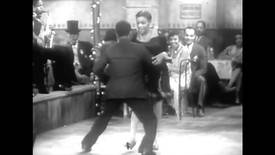 George "Shorty" Snowden with Mattie Purnell in "After Seben."
George "Shorty" Snowden with Mattie Purnell in "After Seben."
There's always two sides to every story:
the Lindy was a "mistake."
Thanks to Jassdancer, a somewhat confusing-- but entertaining-- alternative history to Snowden naming the "Lindy" can be found here. Apparently Snowden and his first partner Mattie Purnell were already several days into the Harlem dance marathon at the Manhattan Casino (Jassdancer calls it the Rockland Palace Ballroom, the name the Manhattan Casino was changed to a few months later) when he lost his grip on her hand. She spun away and he "masked" the "mistake" by throwing in some impromptu steps-on-steroids before grabbing her hand again. That unscheduled breakaway and impromptu dancing brought the audience to life with applause, whistles, and shout backs. Encouraged by the feedback, Snowden and Purnell did it again-- only this time they didn't let go but instead improvised-- like jazz musicians-- on a quick four-beat sequence for all they were worth. That drove the audience nuts. Following the marathon* Jassdancer says Snowden wanted to call this new faster kind of couple dancing "Walk That Broad." But by September 1928 he was back to calling it the Lindy or Lindy Hop. Although the account that the Lindy's origins are based on a "mistake" may be probable, Snowden never mentions any "mistake" in Stearns account. In that version the breakaway and the accelerated dancing was all planned because Snowden "got tired of the same old steps and cut loose with a breakaway. Anything you could dream up was okay for the breakaway, you tried all kinds of things. Everybody did the same starting step, but after that, look out, everybody for himself."
Re this second source, I highly recommend reading it because it gives Snowden more props for his influence on dance than Stearns does in Jazz Dance-- by revealing more of his fearless and entrepreneurial character. For instance, although Stearns gives Snowden credit for facing down Herbert White and starting out on his own as a dancer with the Paul Whiteman Orchestra-- Stearns writes that "Snowden was the first and last dancer to defy Whitey openly and leave the group...a decision that took considerable courage"-- we learn from Jassdancer that Snowden, while still a member of the Jolly Fellows, had founded his own small dance troops, i.e., all of the dancers in the After Seben short are managed by him.
*Fearing for the safety of the contestants, the dance marathon that gave the world "The Lindy," was shut down by the New York Board of Health at 4 A.M. on July 4th (Snowden's birthday) after 18 straight days of dancing. The pacing-- 1-hour of dancing followed by a 15-minuet rest-- wasn't working because by the 18th day should anyone fall asleep, waking up was an impossibility. On that hot July morning, only four couples were still "dancing." George "Shorty" Snowden and Mattie Purnell were one of them. The four couples split the $5,000.00 prize money. George and Mattie walked away with $1,250.00 (about $17, 200.00 in today's money).
To see what a dance marathon from that period looked like, please watch the archival video below. After days, weeks, and sometimes months, contestants begin to look like stumbling, mindless zombies from "The Walking Dead."
the Lindy was a "mistake."
Thanks to Jassdancer, a somewhat confusing-- but entertaining-- alternative history to Snowden naming the "Lindy" can be found here. Apparently Snowden and his first partner Mattie Purnell were already several days into the Harlem dance marathon at the Manhattan Casino (Jassdancer calls it the Rockland Palace Ballroom, the name the Manhattan Casino was changed to a few months later) when he lost his grip on her hand. She spun away and he "masked" the "mistake" by throwing in some impromptu steps-on-steroids before grabbing her hand again. That unscheduled breakaway and impromptu dancing brought the audience to life with applause, whistles, and shout backs. Encouraged by the feedback, Snowden and Purnell did it again-- only this time they didn't let go but instead improvised-- like jazz musicians-- on a quick four-beat sequence for all they were worth. That drove the audience nuts. Following the marathon* Jassdancer says Snowden wanted to call this new faster kind of couple dancing "Walk That Broad." But by September 1928 he was back to calling it the Lindy or Lindy Hop. Although the account that the Lindy's origins are based on a "mistake" may be probable, Snowden never mentions any "mistake" in Stearns account. In that version the breakaway and the accelerated dancing was all planned because Snowden "got tired of the same old steps and cut loose with a breakaway. Anything you could dream up was okay for the breakaway, you tried all kinds of things. Everybody did the same starting step, but after that, look out, everybody for himself."
Re this second source, I highly recommend reading it because it gives Snowden more props for his influence on dance than Stearns does in Jazz Dance-- by revealing more of his fearless and entrepreneurial character. For instance, although Stearns gives Snowden credit for facing down Herbert White and starting out on his own as a dancer with the Paul Whiteman Orchestra-- Stearns writes that "Snowden was the first and last dancer to defy Whitey openly and leave the group...a decision that took considerable courage"-- we learn from Jassdancer that Snowden, while still a member of the Jolly Fellows, had founded his own small dance troops, i.e., all of the dancers in the After Seben short are managed by him.
*Fearing for the safety of the contestants, the dance marathon that gave the world "The Lindy," was shut down by the New York Board of Health at 4 A.M. on July 4th (Snowden's birthday) after 18 straight days of dancing. The pacing-- 1-hour of dancing followed by a 15-minuet rest-- wasn't working because by the 18th day should anyone fall asleep, waking up was an impossibility. On that hot July morning, only four couples were still "dancing." George "Shorty" Snowden and Mattie Purnell were one of them. The four couples split the $5,000.00 prize money. George and Mattie walked away with $1,250.00 (about $17, 200.00 in today's money).
To see what a dance marathon from that period looked like, please watch the archival video below. After days, weeks, and sometimes months, contestants begin to look like stumbling, mindless zombies from "The Walking Dead."
July 14
Born in 1894, Ted Koehler played piano for silent films before moving on to writing for Vaudeville and Broadway theatre and producing nightclub shows. In 1929 he teamed up with Harold Arlen to write the lyrics for their first song, Get Happy. In 1930 producer Ruth Selwyn used it to close the first act of her show The Nine-Fifteen Review. The song became a national hit and caught the attention of the Cotton Club which needed new songs for their new revue. They worked for the Club from 1930 to 1934. During that period they wrote many songs including these timeless hits: I Love A Parade (1931 revue), I've Got The World On A String (1932, the first year of the Cotton Club Parade revues), and Stormy Weather (1933). In 1935, Koehler wrote the lyrics for Animal Crackers In My Soup (music by Ray Henderson) for the Shirley Temple film Curly Top. Koehler died in 1973 at the age of 78.
In Jitterbug! I use Get Happy! as heard on a radio through an open window of a Harlem tenement apartment as the dancical's protagonist Billy Rhythm dances across the street. For those who think "cool" is a modern thing, please check out this version of the song by a dyslexic Jewish vaudevillian named Joe Frisco. It's a clunky Ed Woodish 1930 short called The Song Plugger starring Joe Frisco as himself. He's been called over to a music publisher's office to see if he wants to promote a new song played by "Blind Bob." To give it some umph, a music publisher exec calls in a trio of black horn players who apparently remain in a small closet until they're needed. If you see them play or someone singing in the scene, please let me know. If you're a choreographer, it's worth a watch for its great dance moves and its way cool hat and cigar work. Too much, man!
In Jitterbug! I use Get Happy! as heard on a radio through an open window of a Harlem tenement apartment as the dancical's protagonist Billy Rhythm dances across the street. For those who think "cool" is a modern thing, please check out this version of the song by a dyslexic Jewish vaudevillian named Joe Frisco. It's a clunky Ed Woodish 1930 short called The Song Plugger starring Joe Frisco as himself. He's been called over to a music publisher's office to see if he wants to promote a new song played by "Blind Bob." To give it some umph, a music publisher exec calls in a trio of black horn players who apparently remain in a small closet until they're needed. If you see them play or someone singing in the scene, please let me know. If you're a choreographer, it's worth a watch for its great dance moves and its way cool hat and cigar work. Too much, man!
July 18
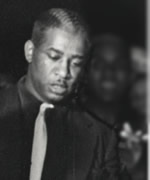 Herbert "Whitey" White
Herbert "Whitey" White
This we know: Herbert White formed the Lindy Hoppers and other Harlem jitterbug dance troupes and exposed the dance to the world. Thanks to Marshall Stearns' great book Jazz Dance we also know this: Herbert White, ex-prizefighter and head bouncer at the Savoy Ballroom, in 1923 founded one of the most feared Harlem street gangs of that time: the Jolly Fellows. According to Stearns, White was much older than most of the gang members and that White fought in WWI in the famous all-black 369th Infantry Division out of Harlem known as the "Hellfighters."* In order to recognize White for his contributions as a "Creative Director" for Jitterbug! we did a search of the unit's roster through the New York State Archives and found one "Herbert White" who was 23 in 1919** when he was discharged following the end of the war. Since many of the gang members-- especially its prized dancers-- were in their teens and twenties-- that would make White at least 25-years older than most of them which would fit in with Stearns' information. Unfortunately, the discharge papers did not include a birth date-- but it did list his address as 2 W. 137th Street which was a couple of blocks south of the Savoy Ballroom (140th and Lenox Ave.). So, maybe, just maybe...
During the heyday of the jitterbug, White managed over 70 dancers in a dozen dance troupes with names like The Savoy Hoppers and The Jive-A-Dears. Of course, the most famous was "Whitey's Lindy Hoppers" which appeared in the film that shook the world, 1937's A Day at the Races. BTW, White's nickname came from a streak of white running through his hair. You can see him standing the the background clapping and encouraging his dancers on in this clip below.
During the heyday of the jitterbug, White managed over 70 dancers in a dozen dance troupes with names like The Savoy Hoppers and The Jive-A-Dears. Of course, the most famous was "Whitey's Lindy Hoppers" which appeared in the film that shook the world, 1937's A Day at the Races. BTW, White's nickname came from a streak of white running through his hair. You can see him standing the the background clapping and encouraging his dancers on in this clip below.
 Chesterfield overcoat
Chesterfield overcoat
Aside from making memorable Hollywood movies, his dancers also traveled the world representing Harlem and showing everyone how to do "it." Most of the dancers were members of the Jolly Fellows (with the women members of the "Jolly Flapperettes"). Aside from their toughness (one act of initiation required the prospective member to walk into a store, clobber the proprietor, and wait for the cops to arrive), the Jolly Fellows were known for their dancers. At the time of this story, one of White's most famous dancers was George "Shorty" Snowden who in 1928 (when he was about 24-years old) told Fox Movietone News (and the world) what dance step he was doing during a marathon dance contest: "The Lindy." He is also responsible in 1928 for securing the northeast corner of the Savoy Ballroom for the Jolly Fellows best dancers: Cat's Corner.
White expected his young charges-- both gang members and troupe dancers-- to look and smell good in public. In fact, when it came time for a gang fight, the Jolly Fellows would arrive dressed in tight Chesterfields (an overcoat popularized through Edward G Robinson's gangster roles), gloves, and derbies. He also expected his gang to respect women and disapproved of "coarse language."
But one of the most unique and important rolls White played in American dance was acting as the gatekeeper for tap dancing. On the Jolly Fellows turf was a store next to the legendary LaFayette Theatre called the Comedy Club. It was a front for a speakeasy and gambling (card tables and a pool table) and the Jolly Fellows ran it. It had a small back room with a battered upright piano up against one wall and a small bench to sit and play it. That ever so small room was called the "Hoofer's Club" and according to Stearns, it was the "unacknowledged headquarters" for tap dancing from the 1920's through the 1940's. Everyone who was anyone would practice his steps there and watch others to pick up new ones-- but no exact copying was allowed upon penalty of getting beat-up or worse, ostracized from the tap dancing community.
White is said to have died sometime in the 1940's a wealthy man.
*Some famous members of the Hellfighters were: Bill "Bojangles" Robinson who served during WWI as the regiment's drum major in its marching band and Noble Sissle who played violin in the band. Besides being a bandleader, Sissle in 1921 teamed up with Eubie Blake to write and produce the first hit musical on Broadway written by and for African Americans: Shuffle Along.
** Updated 5/21/2015: White's military Registration Card was uncovered today. It shows his birth date as July 18, 1894.
White expected his young charges-- both gang members and troupe dancers-- to look and smell good in public. In fact, when it came time for a gang fight, the Jolly Fellows would arrive dressed in tight Chesterfields (an overcoat popularized through Edward G Robinson's gangster roles), gloves, and derbies. He also expected his gang to respect women and disapproved of "coarse language."
But one of the most unique and important rolls White played in American dance was acting as the gatekeeper for tap dancing. On the Jolly Fellows turf was a store next to the legendary LaFayette Theatre called the Comedy Club. It was a front for a speakeasy and gambling (card tables and a pool table) and the Jolly Fellows ran it. It had a small back room with a battered upright piano up against one wall and a small bench to sit and play it. That ever so small room was called the "Hoofer's Club" and according to Stearns, it was the "unacknowledged headquarters" for tap dancing from the 1920's through the 1940's. Everyone who was anyone would practice his steps there and watch others to pick up new ones-- but no exact copying was allowed upon penalty of getting beat-up or worse, ostracized from the tap dancing community.
White is said to have died sometime in the 1940's a wealthy man.
*Some famous members of the Hellfighters were: Bill "Bojangles" Robinson who served during WWI as the regiment's drum major in its marching band and Noble Sissle who played violin in the band. Besides being a bandleader, Sissle in 1921 teamed up with Eubie Blake to write and produce the first hit musical on Broadway written by and for African Americans: Shuffle Along.
** Updated 5/21/2015: White's military Registration Card was uncovered today. It shows his birth date as July 18, 1894.
August 31
Born in NYC in 1907, Edgar Melvin Sampson began his musical career in the 1920's playing for such bands as Duke Ellington's and Fletcher Henderson's. In 1933 the composer and arranger joined the Chick Webb band. During those three years he wrote his most enduring hit "Stompin' At The Savoy." Aside from starting his own band in 1949 he freelanced as an arranger for Benny Goodman, Artie Shaw, Chick Webb and Tito Puente to name just a few. He died in 1973 at the age of 66. You can listen to the original Chick Webb version of "Stompin'" below.
September 20
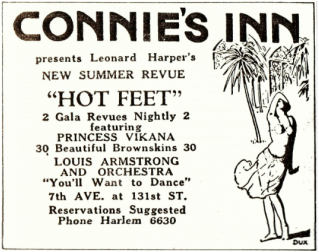
The historical record hasn't been all that kind to Harry Brooks. Although his name is on some of America's most famous songs such as Ain't Misbehavin', Black and Blue, and Jitterbug!'s That Rhythm Man (along with Fats Waller and Andy Razaf), little is known about him-- including no known photographs, hence the Magritte riff with the above poster. What is known is that he was the "keyboardist" in the house band at Connie's Inn in Harlem where Ain't Misbehavin' was born for its Hot Feet revue of 1929. From the review of the show by the Pittsburgh Courier we learn that it was the "first floor show of New York's exclusive nightclubs to be entirely the work of men of color." You can learn more here.
September 26
George Gershwin, born in NYC in 1898, was an American musical genius who died too young (39). Before his 1937 death from a brain tumor, he wrote two of the world's most enduring orchestral pieces (Rhapsody in Blue in 1924 and An American in Paris in 1928) as well as the opera Porgy and Bess (1935, with older brother Ira supplying the lyrics). Not bad for a guy who began his musical career as a "song plugger," someone at the beginning of the 20th century who sang and played the piano to promote and sell sheet music, a job he started when he was 18. Some of the most memorable-- and singable!-- songs the brothers wrote together were: Embraceable You (1930), I Got Rhythm, and Of Thee I Sing (1931). In 1985 the Congressional Gold Medal was awarded to the brothers. Only three other songwriters have received this award (George M. Cohan, Harry Chapin, and Irving Berlin).
For a fun and informative look at the man and his playing style, please click here.
For a fun and informative look at the man and his playing style, please click here.
December 6
Born in NYC in 1896, Ira Gershwin, with his younger brother George, wrote more than a dozen Broadway shows featuring songs like Embraceable You , Fascinating Rhythm, I Got Rhythm, S Wonderful, and They Can't Take That Away From Me. Their first Broadway hit as a songwriting team came in 1924 with Lady, Be Good. In 1935 he and his brother teamed up with DuBose Heyward (author of the 1925 novel Porgy) to write the libretto for the seminal opera Porgy and Bess. The Gershwins' 1931 show Of Thee I Sing was the first musical comedy to win the Pulitzer Prize for Drama (given to Ira who shared it with two other writers of the musical: George S. Kaufman and Morrie Ryskind). The Library of Congress Gershwin Prize for Popular Song was created in 2007 to recognize a composer or performer for his or her lifetime contributions to popular music. Recipients of the award have included Paul Simon (2007), Stevie Wonder (2009), Paul McCartney (2010), and Billy Joel (2014).
December 16
Andy Razaf (Andreamentena Rasafinkarefo) was the grandson of John L. Waller, the first African-American consul to Imerina (later Madagascar). His pregnant 15-year-old mother was married to the nephew of Queen Ranavalona III. Fleeing the 1895 French invasion (where his father was killed), Razaf was born in Washington, DC that year and raised in Harlem. A budding poet, he quit school at 16 to take a job as an elevator operator at a Tin Pan Alley office building. Inspired by what he heard in the elevator, he started writing his own songs. During this period, he slept in the Greyhound Bus station in Times Square and picked up his mail at the Gaiety Theater office building (owned by George M. Cohan at the time and torn down in 1982, it was considered the Black Tin Pan Alley because of the number of African-American songwriters renting offices there). Teaming up with Fats Waller, they wrote such great songs such as Ain't Misbehavin', This Joint is Jumpin', Honeysuckle Rose, and Stompin' At The Savoy. A year before his death in 1973 at the age of 77, Razaf was inducted into the Songwriters Hall of Fame.
December 25
Cab Calloway was born on Christmas Day, 1907, in Rochester, NY but grew up in West Baltimore, MD's Sugar Hill district which was the cultural, political, and business center of black society. He took music and voice lessons while a teenager and-- to his parents' horror-- hung out with jazz musicians (his first friend and mentor was Chick Webb who was from Baltimore). However, it was his older sister Blanche who inspired him to go into show business because she had become an accomplished bandleader before he did with her group Blanche Calloway and her Joy Boys. While attending Crane College (now Malcolm X College) in Chicago, (his father wanted him to become a lawyer), Cab ended up spending most of his time singing at nearby clubs. He met Louis Armstrong in one of those clubs and when Cab began performing with him, the great jazz trumpeter and entertainer taught him how to scat sing. In 1930 he became bandleader of "The Missourians" and once they got hired and started growing a following after replacing the Duke Ellington Orchestra at the Cotton Club in 1931, changed the name of the group to Cab Calloway and his Orchestra. Just 23-years-old when he got the gig through his manager and music publisher Irving Mills, Cab soon recorded his most famous song, Minnie the Moocher. The song-- about a coke addict looking to get high with lyrics buried under jive euphemisms-- became that year's biggest hit and was the first record to sell over a million copies by a black artist. It also associated Cab forever as the "Hi-De-Hi-De-Ho" man, a nonsensical ad lib sung in the scat style. When Duke returned, Cab's band had become so popular that they kept him-- and his wild zoot suit persona-- and the band in the "lineup," becoming the "co-house" band with Ellington's. The twice weekly live national radio broadcasts on NBC Radio from the Cotton Club helped make them household names and broke the major broadcast network color barrier.
Because of Cab's huge success with Minnie, the Cotton Club had its in-house songwriters Harold Arlen and Ted Koehler write a similar song called "Kickin' the Gong Around" which takes its title from a verse from Cab's hit ("Kickin' the gong around" was a slang reference to smoking opium.) It too became a national hit. In 1932, Minnie became the basis and title for an over-the-top animated Betty Boop short. It begins with footage of Cab dancing in front of his band (electrifying and exciting to see even today) before the cartoon begins. When the song comes up on the soundtrack, Cab has been replaced by a Dr. Seuss type of a character that looks like a walrus with legs thanks to an early example of rotoscoping (Cab's dancing is filmed so animators can later use his movements to draw their cartoons over each frame). You can see him sing and dance in the cartoon below-- and if some of the moves look like Michael Jackson's "Moonwalk," its because he borrowed them from Cab-- who called the backward slide the Buzz, a dance step he acknowledged in an 1985 interview had been around "forever."
Because of Cab's huge success with Minnie, the Cotton Club had its in-house songwriters Harold Arlen and Ted Koehler write a similar song called "Kickin' the Gong Around" which takes its title from a verse from Cab's hit ("Kickin' the gong around" was a slang reference to smoking opium.) It too became a national hit. In 1932, Minnie became the basis and title for an over-the-top animated Betty Boop short. It begins with footage of Cab dancing in front of his band (electrifying and exciting to see even today) before the cartoon begins. When the song comes up on the soundtrack, Cab has been replaced by a Dr. Seuss type of a character that looks like a walrus with legs thanks to an early example of rotoscoping (Cab's dancing is filmed so animators can later use his movements to draw their cartoons over each frame). You can see him sing and dance in the cartoon below-- and if some of the moves look like Michael Jackson's "Moonwalk," its because he borrowed them from Cab-- who called the backward slide the Buzz, a dance step he acknowledged in an 1985 interview had been around "forever."
In 1993, Cab was awarded the National Medal of Arts. Created in 1984 by the U.S. Congress, it is the highest honor given for an artist's achievement as awarded by the people and bestowed upon the recipient by the President of the U.S. Cab died the following year at the age of 86. In 1998 his grandson C. "CB" Calloway-Brooks formed the Cab Calloway Orchestra to honor his grandfather's legacy by performing around the world.
